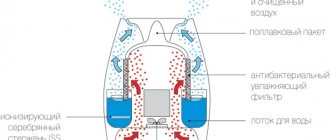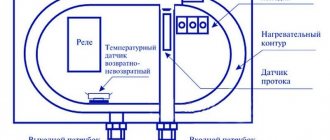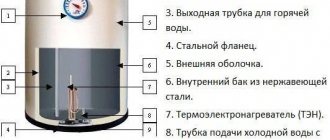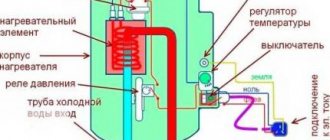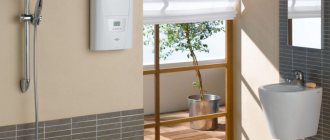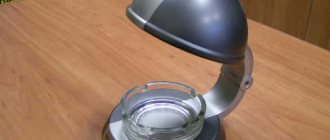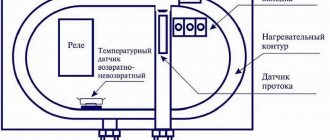Is it worth grounding a water heater in an apartment or in a house?
Liquid from the water supply is an excellent conductor, constantly in contact with the heater of a household appliance, regardless of the type (flow-through or storage). If the wires burn out or the housing of the heating element is destroyed, contact of water with electricity cannot be avoided. Contact with the metal body of the boiler or contact with a stream of water from a faulty device is inevitably accompanied by an electric shock. Due to the fact that it is impossible to quickly get out of the bath or shower, the impact of the current becomes fatal. One of the effective ways to reduce the negative impact (in conjunction with the installation of protective equipment) is to ground the water heater.
Instructions
It is possible to ground a water heater without carrying out construction work to install the circuit in newly built apartment buildings (since 1998). In housing built according to old GOSTs, you will have to make changes to the wiring, install residual current devices (RCDs) or differential circuit breakers. In private houses, installation of a grounding loop is provided.
Grounding installation diagram: square and triangle
In addition to the protective effect in the event of an electric shock from an electric heater, the ground loop in a private home performs the function of maintaining the functionality of other electrical appliances in use. An important function is the equalization of potentials (erroneously in publications they are called “stray currents”), which will protect against damage when a person touches two electrical appliances at the same time or in case of possible “current leaks” of a washing machine or dishwasher. If you do not have enough knowledge of electricity, we strongly recommend that you contact a specialized organization to install grounding. It is not difficult to carry out the general construction part of constructing the circuit yourself, saving money on paying workers. The sequence is:
- They retreat from the foundation of the house by 1.5 - 2 meters, mark and dig a trench in the form of an equilateral triangle with a side of 2 - 2.5 m. The depth of the “ditch” is 50 – 60 cm, the width for the convenience of further work is 40 – 50 cm. From the triangle A trench is prepared against the wall of the house to connect the grounding bus to the electrical panel.
If the soil at the construction site is dry and sandy, then they make not a triangle, but a square with a side length of 1.5 - 2 m. The four pins have a larger area of contact with the ground than in a triangle, which reduces the circuit resistance.
- Two-meter steel reinforcement, the diameter of which is from 12 to 14 mm, is hammered into the corners of the square (triangle). Leave 10 - 15 cm on the surface.
- The free ends of the reinforcement are connected (welded) with a strip of metal. The thickness of the strip is 4 mm, the width is not less than 40 mm. The same strip, welded to the contour, is placed on the walls.
- If several devices need to be grounded, a circuit from the same strip is drawn around the perimeter of the building.
- The trench is filled by compacting the soil. If you have to check the circuit resistance in a few days, the soil can be shed with water for better shrinkage.
Resistance measurements are carried out in dry weather and dry soil - this way the indicators will be more reliable.
- In the right places, 8-10 mm bolts are welded to the circuit - then grounding wires laid from electrical appliances are connected to them.
- The terminal on the device intended for grounding is connected with a copper, necessarily single-core conductor with a cross-section of 4 mm2 or an aluminum conductor with a cross-section of 6 mm2, to a bolt welded to the busbar. Connection type: “bolt”.
Correct connection of a boiler with a storage tank in the bathroom
The bodies of most storage boilers are made of sheet metal.
In places where water is used, this poses an additional electrical hazard. Electric shock from such devices can occur in two cases:
- If the heating element is destroyed. In 95% of storage boilers it is a heating element (tubular electric heater). Poor quality water with a large amount of impurities has an accelerated effect on corrosion, and a collapsed tube promotes contact of water with the wiring phase. Current through the circuit: phase - heating element - water - human body - sewer pipes - earth, causes damage.
- Burning out of the phase wire from the terminal contacts (due to corrosion or burnout) threatens to cause it to fall onto the metal casing, touching which leads to irreparable consequences.
To reduce the danger, they try to install the boiler in a place where accidental contact when taking a shower is excluded (under the ceiling, at a sufficient distance from the bath).
Boilers are powered from separate circuit breakers.
Conventional circuit breakers (popularly called “bag switches”) do not protect a person from electric shock. Such devices are triggered by heating with a strong current, which serves to protect the wiring from fire in the event of a short circuit. Lethal current values are hundreds of times less than the parameters of automatic machines.
In apartments equipped with three-wire wiring, before connecting, you must make sure that the power cord is connected to all three contacts in the terminal block. If the conductors are covered with a multi-colored braid, then the white or brown wire is the phase, the blue one is the working zero (in the diagrams P-contact), the yellow-green protective zero (in the diagrams it is labeled as a PE conductor).
If two-wire wiring is prohibited from being connected, somewhere - in the socket or on the block - there is a protective and working zero.
What to do in such cases is described below.
Boiler grounding methods
The most primitive method of grounding a boiler indoors is to wire the casing to any metal part whose structure goes underground. Suitable for this purpose, for example, is a central heating battery. In modern realities, plastic pipes are becoming increasingly popular among residents; in this case, it is necessary to check the riser, perhaps it is all-metal. In addition, it is important to know that grounding electrical appliances to pipelines and other metal structures is strictly prohibited
, so we strongly recommend avoiding this method of organizing protection (shown in the photo below)!
Terminals for connecting a grounding contact are present in most modern electrical installation devices. This applies, for example, to sockets with “antennae”, which are precisely the conductor for the “ground”. To do it correctly you need:
- Produce with grounding contact. Its location should exceed 80 cm from the floor level and half a meter from the boiler itself.
- If the house is old, it has two-core wires. They need to be replaced with three-wire ones. One of the cores should have green-yellow insulation; this is the correct one to be connected to grounding. The wire goes all the way to the electrical panel, which, in turn, must also be grounded.
- To install a new cable with your own hands, you will have to re-make the groove for it. This is a labor-intensive process. There is an easier way out using, but using it in an apartment is not comme il faut.
- Having turned off the input circuit breaker, you need to connect the required conductors to the socket terminals (observing relative to the “ground”)
- Connect the remaining terminals to the electrical panel. In this case, the ground is connected to a special bus.
If the wiring is two-wire, as, for example, in a Khrushchev building, you can run the third core through a cable channel, thereby avoiding the need for gating. This will avoid mess and a lot of work, but it won't look very right. However, this is one of the frequently implemented options when the cable is two-core.
Another effective way to ground the boiler is to connect it to the water heater line with either a rating of 10 or 30 mA (leakage current). In this case, even if there is no grounding in the apartment, if a dangerous situation arises, an electric shock can be avoided, since the RCD will trip and the entire line will be disconnected from the network. We talked about this in a separate article. We also talked about this separately.
There are cases when residents use the water heater in the bathroom only when it is turned off. That is, first the water is heated, then the boiler is turned off, and only after that the heated liquid is used. The method has a right to exist, but it is extremely inconvenient - the water cools down, there may not be enough of it for the entire washing process, and there is a risk of forgetting to turn off the heater on time. Grounding will solve all these problems.
As an advice
– you need to buy water heaters of the highest quality. They have good insulation of the tubular electric heater, which will eliminate the possibility of breakdown. We talked about this in a separate article.
The process of connecting a grounding contact for a boiler in a country house or in a private house is completely similar to that described for apartments. The only exception is that the structure itself, which can be grounded, must be erected independently and strictly guided by the rules for installing electrical equipment. We talked about this in a separate article.
In conclusion, I would like to note that the need for proper grounding connection for a boiler, like any other powerful electrical appliance, is primarily due to safety. It is the grounding contact of the water heater that will save residents from the potential for a tragedy, and will also ensure safety in terms of eliminating the risk of fire. You shouldn’t play with fate; it’s easier to ground the boiler and make your life calmer. We hope that our step-by-step instructions for grounding a water heater in an apartment or private house were useful for you and helped you install the grounding loop yourself!
You probably don't know:
Like(0) Dislike(0)
As you know, every household appliance with increased electrical power requires grounding. This usually happens by connecting a special contact to the socket and plug. But if it is a water heater, then it may well have a special terminal. How to make grounding for a water heater with your own hands in an apartment or in a country house will be discussed in this article.
How to connect a shower water heater without grounding
If the water heater does not have a terminal for connecting the ground, then you can turn on the water only after turning off the power to the device.
To use the water heater without “pulling it out of the socket,” install residual current devices (RCDs) or an automatic (differential) device.
Without going into the details of the design of the devices, the principle of operation can be described as follows.
The RCD (difavtomat) is connected with one contact to the supply network, and on the other side the wires of the consumer device are connected.
The current from the phase through the heating element returns to RCD zero; it is the same in any part of the closed circuit. If there is a leak in the circuit - in our case through the human body to the ground - then the current at the point where the zero is connected will decrease compared to that leaving the phase. The RCD detects the difference and turns off both power wires. To guarantee protection against damage, the rated breaking current of the RCD must be 30 mA. The parameter is indicated in the RCD passport and on the body with the inscription “IΔn 30mA”.
The importance of grounding a flow-through heater
Due to the absence of a storage tank, the device operates directly through the heating element, interacting with the water flow. Such water heaters must be equipped with grounding.
An example of a possible breakdown of a device best argues for the importance of grounding a flow-through boiler. Let us assume that there is a breakdown of the device
The result of such a phase breakdown of the device body is the formation of a deadly conductive chain:
It is not allowed to use a instantaneous water heater with working grounding without an RCD.
There is a generally binding regulatory regulation for the production of a grounding loop and its electrical installation. The main requirement is to perform work in accordance with all safety requirements.
All rules and specialized requirements for grounding safety precautions must be taken into account by the specialist when carrying out work. There is provision for standardization of data such that it applies to the production of all types of electrical installation and commissioning work, including grounding.
Having summarized the data from the documentation regulating the grounding of various types of electrical equipment, we can highlight the main task of the grounding device - the implementation of the working and protective functions.
Experts strongly recommend not to neglect the grounding of the boiler. The working function of the grounding electrodes increases the service life of the boiler. The stainless steel used in the manufacture of the heating tank is exposed to stray currents. Micropores form and the overall tightness of the device is compromised. Grounding allows you to neutralize the harmful effects on a thermally insulated tank by draining currents.
The production of grounding a water heater can be represented as a complex of sequential implementation of interconnected elements. Each element of the grounding system is very important. A reliable level of electrical safety for residents and a long service life of the water heater are the main arguments in favor of the need to ground the device.
A water heater is a powerful consumer that operates simultaneously with water and electricity. Therefore, the boiler must be grounded without fail. Most apartments do not have it, since the buildings were built a long time ago. You will learn below how to organize a safe connection of equipment.
It ensures stable and uninterrupted operation of the equipment. Main reasons:
- Water is an excellent conductor of current. Since the boiler parts are in constant contact with moisture, grounding allows you to avoid many problems. If the integrity of the wires is broken, you may feel a small shock when you open the faucet or take a bath. This can be deadly. When one of the elements hits the body, an electric shock can occur upon contact.
- Discharge of stray currents. They accumulate in the metal elements of the device and lead to corrosion of the tank and its parts. In addition, a person may feel a slight tingling sensation during use.
- When struck by lightning in a thunderstorm, the ground will take the shock. This way your equipment will remain safe and sound.
How to ground equipment if there is no way to route the wiring into the ground? For example, in an apartment. Many turn to options that are contraindicated. Let's look at them in more detail to prevent problems.
How not to ground a boiler
It is prohibited to carry out the procedure using a heating riser or water supply. Firstly, this leads to corrosion and rapid deterioration of the pipeline. Secondly, you and your loved ones can get an electric shock when touching a boner.
Connect to mounting hardware. This leads to the same consequences as stated above.
Instantaneous water heater without grounding
In some cases, you can organize grounding in houses with two-wire wiring yourself. To do this, an additional insulated single-core wire is laid from the floor panel into the apartment to the socket to which the instantaneous heater is connected. The end of the wire connected to the bus in the panel is equipped with a lug, and the end of the wire connected to the socket is tinned. The socket is replaced with a model with a third, grounding contact. In any case, including an RCD in the consumer circuit will never be superfluous.
The working and protective zeros must be connected to different buses in the electrical distribution panel. If there are doubts about the correct determination of the purpose of the tire, contact the housing department electrician.
How not to ground
It is dangerous to ground a boiler in these ways:
- connect the third wire in the outlet to the water supply or heating;
- combine the neutral and ground contacts in the socket;
- ground several devices one after another.
The listed methods are not suitable because they can increase the voltage. Any malfunction can lead to disaster.
Subscribe to TechnoCouncil on social networks so you don’t miss anything:
What grounding options should not be used?
Publications on some Internet resources offer easy-to-follow but strictly prohibited grounding methods:
- Connecting the third (neutral) wire from the outlet to the water riser or heating radiators. If a phase gets on the body or water, then a dangerous voltage level will flow to the riser and the neighbors who turned on the water will fall under electric potential. This method does not work at all if the pipes are plastic.
- Combining neutral and grounding conductors in a socket.
- Connecting devices to ground in series.
- Connection of several ground conductors to the same bus terminal.
Under no circumstances should you rely on “maybe” when using electrical appliances. This is even more true for water heaters exposed to the aggressive influence of liquids. Mandatory grounding and installation of protection devices in the circuit will save the life of the user and neighbors in the house, and will make the device operate for a long time and without failure.
Instructions for doing the work yourself
Previously, in apartments of multi-storey buildings, grounding of boilers was often carried out by connecting their body to the metal communications of the building, presumably connected to the ground. Heating pipes, water risers, and reinforcement protruding from reinforced concrete structures served such purposes. This was contrary to the rules for operating electrical installations.
Today, a grounding wire is specially installed in the bathrooms of new buildings (for visible external connection), and in general a three-core cable is supplied to all apartment sockets. It is enough to connect the separately output end to a special contact on the body of the water heater.
Distribution boxes with terminals are designed for this connection.
If we are talking about apartments in old houses, where the bathrooms are not equipped with grounding wires, then proceed as follows:
- find out whether a cable with a grounding conductor enters the apartment panel;
- if there is a third yellow-green end in the panel, then you can connect the grounding line from it, but you should first check the connection in the floor panel (if there is no connection there, make a bolted connection to a special clamp);
- when the panel in the apartment does not contain a grounding conductor, then the entire line from the floor distribution board should be mounted.
The power supply to the apartment sockets of such buildings is carried out mainly by two-wire wires. To ground the power points, you will need to completely replace the wiring.
In addition to laying a three-core cable, private homes will require the creation of a grounding loop. In this case, the procedure is as follows:
- at a distance of 3 to 5 meters from the house and the shield, dig a hole about half a meter deep;
- according to the diagram of an isosceles triangle (side dimensions 1200-1500 mm), metal pins (pipes) with a diameter of 1.5 cm and a length of at least 2 meters are driven in;
- the upper parts of the electrodes are connected by welding with a metal bus with a width of at least 4 cm and a thickness of 0.4 cm;
- a grounding conductor is attached to a bolt or welded tip to the busbar and brought to the shield;
- bury the structure.
Thus, the boiler is grounded along two lines: through the socket and visible external one. They are connected on a special busbar of the distribution panel.
